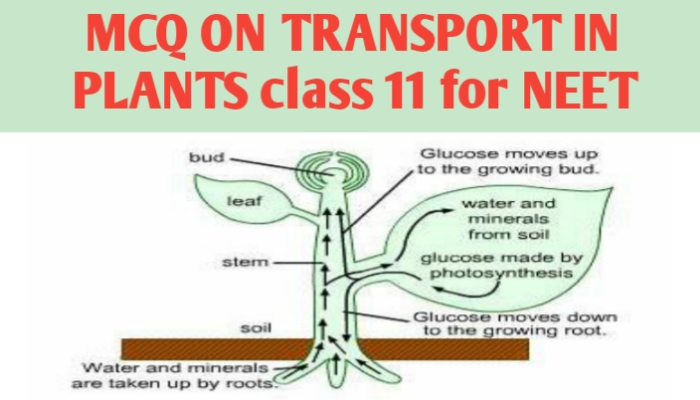MCQ ON TRANSPORT IN PLANTS class 11 for NEET | TRANSPORT IN PLANTS class 11 MCQ | TRANSPORT IN PLANTS with Answer | Check the below NCERT MCQ question for class 11 Biology chapter 11 based on the TRANSPORT IN PLANTS with Answers.
MCQ on TRANSPORT IN PLANTS class 11 Biology with answers were prepared based on the latest pattern.We have provided class 11 Biology MCQs questions on TRANSPORT IN PLANTS with Answers to help students understand the concept very well.
MCQ TRANSPORT IN PLANTS is useful for NEET / CSIR / UGC / CBSE / ICSE / AIIMS / EXAM / AFMC EXAM / STATE LEVEL MEDICAL EXAM 2022-23
Introduction:-
Have you ever wondered how water reaches the top of tall trees or for that matter how and why substances move from one cell to the other , whether all substances move in a similar way , in same direction and whether metabolic energy is required for moving substances.Plants need to move molecules over very long distances , much more than animals do.
MCQ ON TRANSPORT IN PLANTS class 11 for NEET
1. The transport over long distances proceeds through the vascular system is called
(a) osmosis
(b) diffusion
(c) translocation
(d) all the above
Ans (c) translocation
2. In rooted plants, transport in xylem of water and minerals is essentially
(a) bidirectional
(b) unidirectional
(c) multiple directional
(d) All the above
Ans. (a) unidirectional
3. Organic and mineral nutrients however undergo …… transport
(a) unidirectional
(b) multidirectional
(c) bidirectional
(d) none
Ans. (b) multidirectional
4. The movement by diffusion is
(a) active
(b) passive
(c) osmosis
(d) none
Ans.(b) passive
5.The diffusion rate are affected by
(a) gradient of concentration
(b) the permeability of the membrane separating
(c) temperature and pressure
(d) all the above
Ans.(d) all the above
6. The proteins that form huge pores in the outer membranes of the plastids, mitochondria and some bacteria allowing molecules up to the size of small proteins to pass through.
(a) aquaporins
(b) porins
(c) symport
(d) antiport
Ans.(b) porins
ALSO READ:-
● YOU CAN WATCH BIOLOGY SIR Youtube channel
7. Which transport uses energy to pump molecules against a concentration gradient.
(a) passive transport
(b) active transport
(c) osmosis
(d) diffusion
Ans.(b) active transport

MCQ ON TRANSPORT IN PLANTS class 11 for NEET
8. Terrestrial plants take up huge amount water daily but most of it is lost to the air through evaporation from the leaves .
(a) osmosis
(b) diffusion
(c) transpiration
(d) active transport
Ans.(c) transpiration
9. The two main components that determine water potential.
(a) solute potential
(b) pressure potential
(c) both a and b
(d) none
Ans. (c) both a and b
10.The process of movement of substances down a gradient of free energy is called
(a) osmosis
(b) passive transport
(c) active transport
(d) diffusion
Ans. (d) diffusion
11. By convention , the water potential of pure water at standard temperature, which is not under at any pressure, is taken to be
(a) one
(b) hundred
(c) zero
(d) none of the above
Ans.(c) zero
12. The term used to refer specifically to the diffusion of water across a differentially or semi – permeable membrane.
(a) active transport
(b) passive transport
(c) osmosis
(d) All the above
Ans.(c) osmosis
13. If the external solution balances the osmotic pressure of the cytoplasm,it is said to be
(a) isotonic
(b) hypotonic
(c) hypertonic
(d) all the above
Ans. (a) isotonic
14. Cell swells in
(a) hypertonic solution
(b) hypotonic solution
(c) isotonic solution
(d) none of above
Ans.(b) hypotonic solution
15. Cell shrink in
(a) isotonic solution
(b) hypertonic solution
(c) hypotonic solution
(d) all the above
Ans. (b) hypertonic solution
16.The absorption of water by seeds and dry wood
(a) osmosis
(b) diffusion
(c) imbitition
(d) active transport
Ans.(c) imbitition
17. The symplastic system is the system of interconnected protoplasts , neighbouring cells are connected through cytoplasmic strands that extends through
(a) osmosis
(b) diffusion
(c) plasmodesmata
(d) both a and c
Ans.(c) plasmodesmata
18. The inner boundary of the cortex, the endodemis is impervious to water because of a band of suberised matrix called the
(a) symplastic
(b) apoplast
(c) cellulose
(d) casparian strip
And.(d) casparian strip
19. The symbiotic association of a fungus with a root system.
(a) lichen
(b) mycorrhiza
(c) tracheids
(d) All the above
Ans. (b) mycorrhiza
20. Phloem is responsible for transport for food primarily……from the source to sink
(a) glucose
(b) fructose
(c) sucrose
(d) all the above
Ans.(c) sucrose







Leave a Comment